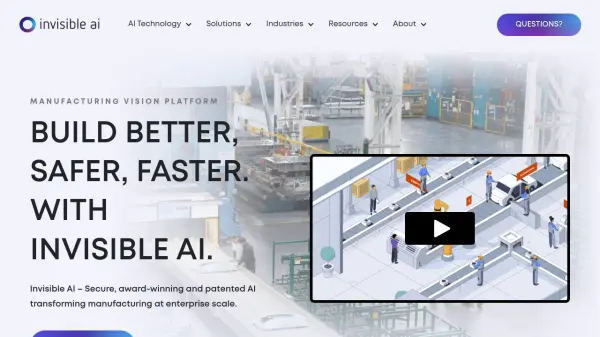What is Invisible AI?
Invisible AI offers a sophisticated manufacturing vision platform powered by patented Artificial Intelligence and computer vision technology. It is designed to digitize the physical world of the factory floor by analyzing human motion and object interactions in real-time. The system utilizes an NVIDIA-powered AI chipset and synchronized depth-sensing cameras integrated into its devices, enabling manufacturers to enhance operational efficiency significantly.
This platform facilitates improvements across various manufacturing domains, including safety, quality control, production throughput, and continuous improvement initiatives. By providing detailed insights into workforce movements and process cycles without relying on cloud access, Invisible AI helps teams proactively identify safety risks, streamline root-cause analysis for quality issues, pinpoint production bottlenecks, and implement targeted improvements for better overall labor effectiveness and faster time-to-value.
Features
- Real-time Motion & Object Analysis: Utilizes AI and computer vision to monitor factory floor activities.
- On-Premise Edge Computing: Features built-in AI chipset and 3D cameras for local processing and storage (up to 3 months/2TB per device).
- PLC / MES Integration: Connects workforce movement data with existing manufacturing execution systems.
- Ergonomics Monitoring: Analyzes worker movements to identify potential ergonomic risks.
- Forklift Tracking: Monitors forklift activity for safety and efficiency.
- Incident Root-Cause Analysis: Facilitates quick investigation of safety or quality incidents using 3D video capture.
- AI Time Studies: Automatically conducts time studies to analyze cycle times and identify outliers.
- Bottleneck Identification: Helps pinpoint constraints in the production flow.
- Product Traceability: Allows users to view a product's lifecycle and track it via serial number using streamlined search and 3D video.
- Line Balancing Support: Provides data to aid in optimizing workstation workloads.
Use Cases
- Enhancing workplace safety through proactive ergonomics monitoring and incident analysis.
- Improving manufacturing quality control via rapid root-cause analysis of defects.
- Boosting production throughput by identifying and resolving bottlenecks.
- Optimizing labor effectiveness with AI-driven time studies and cycle analysis.
- Facilitating continuous improvement (Kaizen) projects with detailed operational data.
- Streamlining line balancing and workstation optimization.
- Providing irrefutable product traceability throughout the manufacturing process.
- Monitoring and improving the efficiency of material handling equipment like forklifts and AGVs.
Related Queries
Helpful for people in the following professions
Invisible AI Uptime Monitor
Average Uptime
100%
Average Response Time
212.73 ms
Featured Tools
Join Our Newsletter
Stay updated with the latest AI tools, news, and offers by subscribing to our weekly newsletter.











